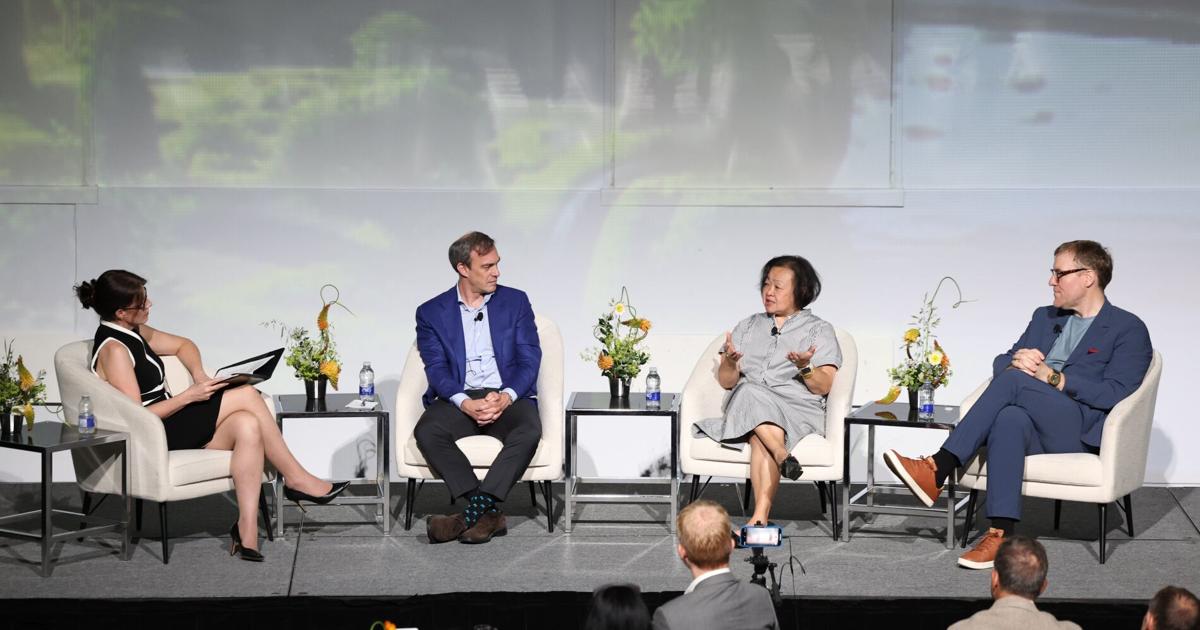Three of the most influential voices in artificial intelligence say Toronto boasts a deep AI talent pool — but warn that the city must speed up innovation and scale its AI industry or risk losing its competitive edge.
Avi Goldfarb, the Rotman Chair in Artificial Intelligence and Health Care, Joyce Drohan, Ontario’s first Chief AI and Technology Officer, and Daniel Wigdor, co-founder and CEO of AXL, discussed how AI will reshape the workplace and the economy during a panel moderated by Toronto Star Editor-in-Chief Nicole MacIntyre at the city’s Design Exchange on June 25.
“AI is Toronto’s hidden opportunity. Toronto is also number one in the world for applied computing, which is where the real opportunity for these things is going to lie,” Wigdor told the lunchtime crowd.
Goldfarb said the headline right now is that companies from all over the world come to Toronto to hire our talent. But if that talent continues to leave, in five years Toronto will be facing a “nightmare scenario.”
AI will bring big change to industries
The panellists told the audience they each hold different views about which industries are poised for the biggest change thanks to AI and which ones are the most at risk if they don’t adopt the technology fast.
Drohan said she believes AI-enabled tools powered by massive quantitative data will drive the biggest shift in health care, given the growing demand caused by the ongoing shortage of doctors and nurses. But existing privacy regulations sometimes limit our ability to merge data for a comprehensive view of health care, she added.
Goldfarb noted that health care is particularly difficult to reform in Ontario and may take decades to evolve. He pointed to the field of marketing, an industry that has always been transformed by technology, as one that could change more quickly.
Marketing is heading into a new era where AI chatbots are reshaping how people seek out and communicate information — and marketers need to figure out how to reach consumers, even though, as he put it, “there’s no real infrastructure for that yet.”
Wigdor argued that jobs centred on original content creation may be at risk with the rise of AI, but he also sees new opportunities emerging in the creative arts industry.
“Right now we build films on a one-to-many model,” said Wigdor. ”(With AI) we’ll be able to create our art in a way that will adapt to the people who are watching it. I think the people who are able to make that transition are the ones who are going to be the real winners.”
Prepare to retrain in an AI era
It is an undeniable reality that AI is fuelling widespread anxiety about job security, particularly among teenagers who face uncertainty about the nature of the workforce they will soon enter.
Wigdor said AI as a tool will redefine job requirements and expects AI will change the way teams collaborate on entry-level work within organizations.
“Just look at what are the entry-level jobs today, and say, how could I combine three of those together, and use AI to let me do the work of those three jobs? That just will be the entry-level job of the future,” he explained.
Drohan noted that the standards that young people starting internships will be expected to meet will be greater, as simply conducting basic research or compiling documents will no longer suffice — interns will need to have a clearer idea of what they want to accomplish with their career.
Goldfarb said those already in the workforce should be prepared to retrain every 10 years in a world constantly changing because of AI.
He added that when one person can do the work of 10 thanks to AI, company leaders need to rethink how they manage these “super-powered” employees. Rather than simply laying off the remaining nine employees, a better strategy would be to recognize the opportunity to be 10 times more productive than before.
“Don’t forget, your competitors are also doing 10 times as much, and so if you just let them go, then you’re giving up so much of what could happen,” he said.
Wigdor said companies should eliminate the stigma around using AI, noting that many employees already rely on these tools without disclosing it. If they are using free versions of AI tools, he warned, there’s a risk sensitive business information could be used to train AI programs.
Wigdor also stressed that as individuals worldwide explore AI’s potential to disrupt existing businesses, organizations must proactively think ahead about how AI could reshape or even replace them.
Will AI create more inequality than it solves?
Before the panel delved into the question of how strongly AI should be regulated, MacIntyre posed the question: Do you agree that AI will create more inequality than it solves in the next decade?
On this, Goldfarb disagreed — but both Drohan and Wigdor said yes.
Goldfarb explained that while he supports “aggressive” antitrust policies to preserve competition in the AI industry, he believes there are valid reasons for taking a “light touch” approach to regulation.
“I think Canada’s per capita income hasn’t grown in something like 10 years. This is the technology of everything that we have out there that’s most likely to solve that problem,” he said.
Wigdor echoed the sentiment, noting that Silicon Valley was built on major U.S. defence investments that helped train a generation of engineers. He warned that Canada would risk undoing its own progress in AI by stifling innovation and letting talent continue to flow south.
Drohan said she doesn’t believe Canada aims to be the most restricted or heavily regulated jurisdiction in the world — but emphasized that regulations should address potential harms to children and marginalized communities, adding, “That’s who we are as Canadians.”
“The regulations have to modernize because the privacy rules came in decades ago when AI wasn’t around,” she said.
Could AI diagnose your health problem?
Drohan pointed to health care as an example, noting that the biggest barrier to advancing AI in the field has been data sharing and consent. She said Canada has a vast health-care data set that could be leveraged to train AI — but doing so will require updating current privacy rules and regulations.
While AI is close to matching the ability to make predictions to guide diagnoses and treatment, Goldfarb said the real challenge lies not in the technology but in redefining roles — shifting the focus away from doctors and figuring out how to train nurses or new professionals to take on that central role.
When asked if patients would want AI-assisted diagnoses, Goldfarb suggested they might appreciate a model where primary care professionals are selected for empathy and their ability to guide patients through the health-care system.
“The visions are there, it’s just making it happen requires a lot of regulators to co-operate,” said Goldfarb.
How far are we?
Wigdor, who is also a professor at the University of Toronto, says he believes we’re only at 0.1 out of 10 on the AI development scale. He likens today’s accessible AI chatbots to black-and-white Charlie Chaplin films — a far cry, he says, from what AI will eventually become in the decades ahead.
“It’s because it takes a while where people use this technology to see what it’s really for. And so those of us who’ve been working in applied AI for decades, we started to see uses of these things far beyond like chat interfaces,” he said.
Goldfarb said that although companies are investing in AI now, it will take a few years before businesses see returns — and even longer for policy impacts.
He estimated we’re currently at about three out of 10 in terms of AI’s transformation of daily life and the city.
“For most of us in our day-to-day lives, it hasn’t happened yet.”



